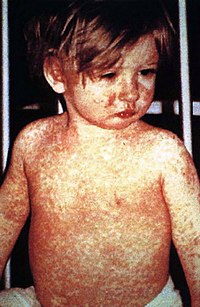
Photo from wikipedia
Dear Editor, A 5-year-old girl presented with a 1-year history of slightly pruritic erythematous annular plaques covering her trunk and limbs (Fig. 1). The remaining integument as well as the… Click to show full abstract
Dear Editor, A 5-year-old girl presented with a 1-year history of slightly pruritic erythematous annular plaques covering her trunk and limbs (Fig. 1). The remaining integument as well as the mucous membranes were not affected. The lesions persisted for about 1 week slowly developing a more violaceous hue before disappearing. The patient’s parents reported on recurrent episodes of fever (maximum: 39°C) once a month accompanied by arthralgia, especially of the knee, ankle, wrist and shoulders. Joint swelling, erythema or hyperthermia did not accompany these episodes. The patient had no past medical history. There were no circulatory or respiratory symptoms, no gastrointestinal complaints, in particular no diarrhoea, blood or mucus secretions in the stool. Laboratory tests including total blood count and metabolic panel showed no abnormalities, especially no peripheral blood eosinophilia, no increased IgE, ANA or ENA titres. Therapy with pimecrolimus cream and oral antihistamines was not sufficient. Oral prednisolone (30 mg daily) leads to partial remission. Nevertheless, the cutaneous lesions reoccurred after reduction in the prednisolone dose. To rule out cryopyrin-associated periodic syndromes (CAPS), that typically present with recurrent fever and arthralgia, a genetic screening was performed. No mutations in exon 3, exon 4 and exon 6 of the NLRP3 gene and in exon–intron flanking regions of NLRP3 gene were found. Histopathology of a punch biopsy revealed a superficial and deep perivascular infiltrate with abundant eosinophils. There were neither signs of leucocytoclastic vasculitis nor flame figures. Furthermore, a basal melanosis of the epidermis was evident (Fig. 2a,b). Clinicopathological correlation was consistent with a diagnosis of eosinophilic annular erythema (EAE). An off-label therapy with hydroxychloroquine was discussed with the patient’s parents, but spontaneous resolution occurred during the pretreatment investigations. A follow-up visit 12 months later showed sustained remission. Eosinophilic annular erythema is a rare self-limiting disease, associated with annular urticarial skin lesions and tissue eosinophilia. Initially, it was described in children, but there are also adult cases published. Eosinophilic annular erythema is typically not associated with systemic symptoms such as fever and arthralgia. Nevertheless, our patient presented with both symptoms. Although no mutations of the NLRP3 gene were found, we could not definitely exclude CAPS based on mutational analysis, as only 60% of patients with CAPS reveal symptomatic germline mutations. Subsequent histopathological examination showed superficial and deep eosinophil-rich perivascular infiltrates devoid of neutrophils that are typically seen in CAPS. Additionally, basal melanosis was seen in our patient, a feature that was described to be pathognomonic for EAE. These findings enabled us to rule out CAPS, Well’s syndrome, urticarial vasculitis and to diagnose EAE. Figure 1 (a,b) Erythematous annular plaques in a 5-year-old girl. Figure 2 (a) Histopathology showed an eosinophil-rich superficial and deep perivascular infiltrate (original magnification 9200). (b) Close-up (original magnification 9400).
Journal Title: Journal of the European Academy of Dermatology and Venereology
Year Published: 2018
Link to full text (if available)
Share on Social Media: Sign Up to like & get
recommendations!